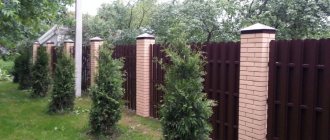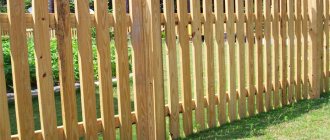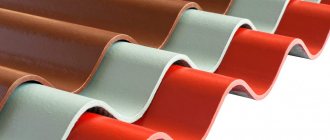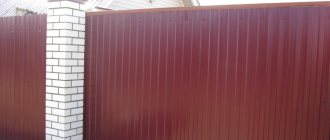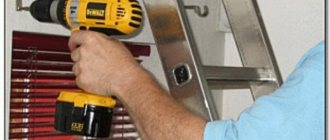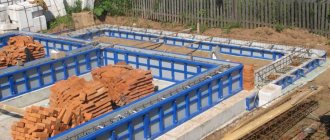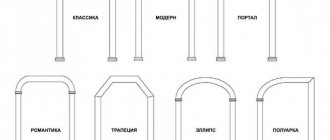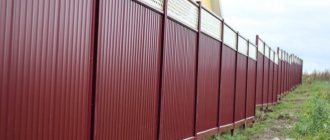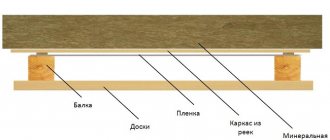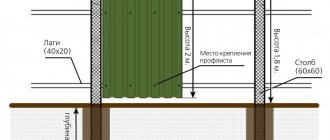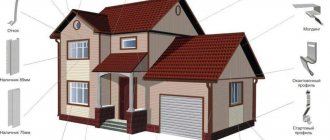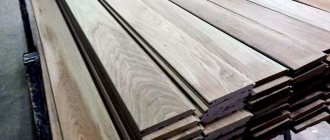A fence is a mandatory attribute of any site. Its function is both to protect the site from the influence of outsiders and to decorate the house. In addition, the fence is necessary for land surveying and dividing the land into zones.
In this article we will talk about how to make a beautiful and, at the same time, affordable fence.
Construction materials
Undoubtedly, fences made of stone, brick, corrugated board or wood are especially popular, but these materials are not budget-friendly and not everyone can afford such a fence.
A fence made of chain-link or welded mesh that seems cheap at first glance will also hit the family budget, if you take into account the cost of transportation and installation of the fence. Despite this, the fence is still the face of the site, so you should not skimp on it.
There are many ideas on what a fence can be made from. If you still decide not to spend money on expensive fencing, then take note of fence options made from scrap materials, such as:
- Unnecessary pallets.
- Used slate.
- Various plastic parts, for example old containers.
- Production network.
- Waste from sawmill.
- Branches of bushes and trees.
- Unfinished boards.
- Scrap metal. If you have a car, you can visit scrap metal warehouses and purchase pipes, poles and crossbars there.
- Used brick, stone and concrete.
What types of fences are there for a home?
Modern building materials make it possible to realize the most fantastic and original ideas when constructing fences for private houses. Fences are divided into different types according to their design and materials used. There are several varieties:
Based on materials:
- Wooden fences - planks, picket fences, picket fences, panel fences, veneered fences, wattle fence.
- Fences made of brick or block (cinder blocks, foam blocks) masonry.
- Stone fences – artificial or natural stone.
- Concrete fences - monolithic by pouring concrete or from reinforced concrete panels.
- Metal fences - forged, mesh, lattice, made of corrugated sheets, metal sheets, profile pipes.
- Fencing using slate sheets.
- Plastic fences - panels, siding, block house. Polycarbonate fences stand out in particular.
- Glass fencing.
- Hedge.
- Combined options - a different combination of these varieties is used.
Based on their design, there are monolithic (stationary, non-dismountable), prefabricated (collapsible) and mobile (temporary, portable) structures.
According to installation features:
- production by masonry;
- welded structures;
- with a foundation (strip or columnar) or on the ground;
- by driving piles;
- planting;
- frame type.
According to the design decision - forged, openwork, with decorative inserts, special design of the upper part, original columns, etc.
When choosing the type of fencing, first of all you should pay attention to reliability and durability. Their strength must withstand strong gusts of wind and snow loads, as well as mechanical stress. The material must be resistant to any climatic influences (water, solar ultraviolet radiation, high temperatures in summer, temperature changes, frost, etc.).
We recommend: Requirements for load-bearing frames for wooden houses
Almost all fences consist of the following basic elements - a foundation (base), support pillars and spans between supports. Even when constructing monolithic walls, this principle of structural formation is preserved. In prefabricated systems, load-bearing horizontal elements are attached between the pillars, onto which a covering made of different materials is mounted.
Features of wooden structures
The most common material for making fences is lumber (wood) . Wood has such positive qualities as
- ease of processing and installation;
- variety of forms;
- low cost;
- natural appearance and environmental friendliness.
Such a fence around a wooden house, against the backdrop of a garden and flowering shrubs, looks especially harmonious.
The main disadvantage is the tendency to rot under the influence of moisture and cracking during operation, reduced mechanical resistance to shock, the possibility of pests and fungi, and flammability. Wooden parts must be impregnated with an antiseptic composition, and it is advisable to apply a protective coating (paint, enamel, varnish) on top.
The following main types of wooden structures can be distinguished.
plank fence
Support posts are made of logs or timber . Horizontal beams are mounted between them, onto which boards are then fixed. They can be installed with a gap (translucent type) or closely (solid fence), without gaps.
Sometimes the “overlap” method is used, when the boards overlap each other. This design is highly decorative. One of the common options is a picket fence . In this case, the upper part of the board ends with a pointed triangle.
Paving stones
A fencing is made from timber in a similar way to a plank fence, but this design is more massive and reliable. A blind fence is mounted from profiled timber.
Fence
In this design, wooden slats (pickets) up to 10 cm wide are fixed to horizontal load-bearing elements with a gap.
Such a fence can be of different heights. The most elegant look is the European picket fence , which is of high quality.
Slatted fencing
Transparent type fences can be made in the form of a lattice made of wooden slats. In this design, the span is made in the form of a rectangular frame made of timber, and a slatted mesh is formed inside it, and the slats can be positioned horizontally, vertically, or diagonally.
Panel structure
The main difference of such a fence is that the entire span is assembled in the form of a shield from boards, plywood, chipboard, and then attached to support posts.
A massive fence can be assembled according to the fortress type - from logs in the shape of a log house. Such a fence will help in areas where large, wild animals live.
Wooden fencing has low durability - the average service life is 16-17 years. Painting and varnishing wood helps to improve it somewhat, but repairs must be carried out in a timely manner and in full.
Stone fences
Natural stone allows you to build a beautiful and impressive, monolithic fence. It is characterized by high strength, inaccessibility and increased durability (at least 50 years).
An important advantage is that stone walls do not require special care. This design will fit into different styles of landscape design. Disadvantages include the high cost and difficulty of doing it yourself.
To build a fence, cobblestones of different sizes, rubble, limestone, and sandstone are most often used. As a base, a strip foundation is made along the entire perimeter.
The supporting stone columns have an increased thickness compared to the masonry spans. For reliability, it is better to reinforce them with steel vertical rods.
You can reduce the cost of fencing by using artificial stone, which is much cheaper. It is sold in the form of blocks, and therefore it is easier to make masonry from it.
Brickwork
Brick fences are very popular among owners of rich houses who do not strive to save money. When using high-quality brick, there is no point in covering the wall with something on top - it looks great and will retain its appearance for a long time. Compared to a stone fence, a brick structure is less resistant to impact loads and during operation is subject to aging under the influence of atmospheric conditions.
Cheaper and lower quality bricks may begin to crumble after 5-6 years. Plaster helps increase its service life . On top of this layer you can paint it any color or whiten it.
By analogy with stone, a brick fence includes massive support pillars with reinforcement and less thick spans. The span can be laid with a thickness of 0.5 - 1 brick. Sometimes it is made with gaps or with protrusions of individual bricks in a certain order, which provides an original appearance.
Construction of concrete fences
Concrete fences can be erected by pouring ( monolithic structure ) or from reinforced concrete slabs ( collapsible structure ). In the first case, support pillars are first made of concrete with reinforcing linkage in the longitudinal, transverse and vertical directions. Then the formwork is installed and the spans are poured in the form of concrete walls 10-20 cm thick.
The surface of the spans can be decorated with marble chips or decorative colored plaster. A simpler option involves painting or whitewashing. At the top of the concrete span, various elements can be formed - an arch, a battlement, a tent , etc.
The fastest option for erecting a fence is installing reinforced concrete slabs . This option will provide high strength to the structure, but requires the use of lifting mechanisms. To install the fence, it is better to use special reinforced concrete pillars, which have grooves on both sides for installing slabs. In this case, welding or other methods of attaching the span to the support pillars will not be required.
We recommend: How and where to register a water meter - features of the procedure
Metal constructions
Metal fences have high strength and durability. Quite attractive structures with a respectable appearance are built from various metal elements. They can have the following varieties:
- Fence made of corrugated board . A chic, solid fence can be made from corrugated sheets with a protective plastic coating. This material is not subject to corrosion and will last for many years. It is available in different color shades. An economy class fence can be built from a standard profiled sheet (without coating). It looks much more modest and requires subsequent painting, but is much cheaper.
- Mesh structures . The following common options can be distinguished: a span in the form of sections made of a profile pipe covered with a metal mesh, and a fence made of chain-link mesh.
- Metal picket fence . This design has become very popular recently. This is how a semi-closed fence is erected. Neatness and aesthetic appearance can be achieved when using products of the “Euro picket fence” category.
- Forged fences . These transparent fences are expensive, but look impressive. In their production, purchased forged parts or custom-made elements are used.
- Welded or openwork structures . Metal strips, rods, rods are given various shapes, and by welding them together it is possible to reproduce a real work of art on the fence.
Metal elements require reliable protection against corrosion. For this purpose, paints or special primers are used.
Slate fences
Slate sheets installed vertically provide the required fence span height.
An important advantage of this design is speed and ease of installation. Disadvantage: low impact strength . Slate can be mounted on wooden supporting beams, fixed horizontally between supports.
Combined designs
Quite often, various combinations of different materials are used in the manufacture of fences. The most common combined structure is concrete or brick support pillars, and the spans are made of any other material.
More complex combinations can be used in the manufacture of spans. The option looks impressive when the bottom of the span is made using stone or brick masonry with the formation of a semicircular recess. A metal, openwork plexus is mounted in such an opening.
Plastic fences
Plastic is increasingly being used in building structures and fences are no exception. Plastic fences are distinguished by their resistance to weathering, lightness, ease of installation, and low cost. Disadvantages - low resistance to scratching, rapid contamination, insufficient decorative effect.
is most widespread in the form of slabs, sheets and panels . With their help, the following types of fences are erected:
- blank sheets;
- fence;
- wattle fence;
- from narrow panels similar to a board;
- mesh type.
The plastic fence made of polycarbonate stands out especially. This modern material is an analogue of silicate glass, but has flexibility and impact resistance. With its help you can build transparent fences.
Combined structures look original - the bottom is in the form of stone or brickwork, and the top is made of transparent or tinted polycarbonate.
Using a hedge
A hedge-like fence is formed by planting shrubs or climbing plants in a row. By branching, they create an original wall from their stems and leaves. Deciduous, evergreen or flowering plants are used. The following varieties are distinguished by height: low (no more than 1 m), medium height (1.1-1.6 m) and high (above 1.6 m) hedges.
The advantage of a plant fence is unity with nature, floral aroma, moisture retention . Among the disadvantages, the following factors should be highlighted: the need for watering and other plant care, the accumulation of harmful insects and rodents, and delayed snow melting.
Glass structures
Fans of original design are attracted by the use of high-strength glass in the construction of fences. This material visually expands the space and provides many design options.
Currently, unbreakable glass sheets are offered for this purpose - transparent, frosted and color-tinted. With numerous design advantages, the most important drawback should be noted - high cost.
Stages of construction
How to build a fence with your own hands? So, the construction of the fence takes place in several stages:
Planning and marking. Before starting work, it is necessary to draw up a drawing of the fence indicating its dimensions and the location of the gate and wicket. Then we transfer the drawing to the construction site.
Read here - Gate lock: types and features of locks, selection tips and do-it-yourself installation (video + 90 photos)
The boundaries of the future fence must be marked with pegs and twine stretched between them. Additionally, using pegs, you need to mark the location of the support pillars. The distance between them should be from 2 to 3 meters.
Foundation. If you are building a stone or brick fence, then keep in mind that such a massive structure requires a solid foundation. The approximate depth of the trench for the foundation is 70 centimeters and the width is 40.
Installation of support pillars. Laying fence spans.
After learning more about the stages of fence construction, you will know exactly how to make a fence correctly.
Brick, stone, fence
Please note that the masonry joints must be filled, they are about a centimeter.
For those who are not bothered by the high cost of installation and materials, but who need durability, functionality and strength, the option of a brick fence is suitable. To install it, you will need to install a strip foundation, so professional help is advisable. The work phase will be as follows:
- Using a rope and pegs, draw the outline of the future fence.
- Dig a trench that will be used for the strip foundation.
- Fill the foundation with concrete mixture and let it sit for several days.
- Lay out a trial bottom row.
- Create masonry mortar.
- Lay the second row of bricks using masonry mortar.
Please note that the masonry joints must be filled, they are about a centimeter.
- Remove excess solution.
- Finish the seams with jointing.
A stone fence is built in a similar way. The material, as a rule, is natural stone - limestone, granite, sandstone. The thickness of the masonry is at least 40 cm. The construction technology is very similar to the technology for constructing a brick fence, but there are some nuances:
- Build support pillars at a distance of 8-10 m from each other.
- Using masonry mortar, build stone fences.
- Cover stone fences with tiles or plaster.
Corrugated fence
A fence made of a material such as profiled decking will favorably emphasize and highlight your site among others and reliably protect it from strangers. How to make a fence from corrugated board?
Installing a fence made of corrugated sheets does not cause difficulties even for beginners. Installing such a fence is completely justified due to the advantages:
- Simplicity of technological work during installation.
- Strength of the material.
- Long service life.
- Modern style.
A self-made fence made of corrugated sheets is an ideal option for a personal plot.
Price
The cost of erecting a fence depends on many factors. Here are some of them:
- Foundation dimensions. The amount of mortar that will be used for construction depends on this parameter. Accordingly, the heavier the fence, the more massive the foundation must be laid.
- Fence size.
- Material for construction.
- Installation. You can save a lot on installing a fence if you decide to build it yourself, without the help of specialists.
In order to find out how much it will cost to make a fence, you need to determine its exact dimensions and choose the material for construction.
Fencing standards
A fence is a construction project that encloses a certain area. Various options fall under this concept - from a low hedge to monumental, blind structures . The main purpose is to limit private property along its perimeter. In addition, fences can have protective and decorative functions .
There are 2 main types of fencing:
- External fence. It separates the territory from the street - the roadway and pedestrian zone. This is the front part of the site where the main entrance is located.
- Fencing between adjacent plots . Such a fence establishes a boundary between neighboring landholdings.
The construction of fences is regulated by SNiP, and the standards differ somewhat for these categories of fences. Violation of applicable rules may result in legal proceedings and fines.
The following requirements are put forward for external installation fences:
- The height of the fence should not exceed 2.3 m for a one-story residential building, and the upper part of the building should be visible from the street. For two- or three-story buildings, the construction of higher fences is allowed, but in agreement with the relevant authorities.
- The fence can be solid, transparent or translucent.
- The design of the fence should not create a risk of injury to passers-by. For example, the use of barbed wire or “spikes” directed toward the sidewalk is prohibited.
- When building monolithic fences, it is necessary to solve the problem of drainage.
- Gates installed on the outside should not interfere with pedestrians when opening.
- Color options may be limited by local authority decisions.
The following restrictions apply to fences between neighbors:
- The height of the fence can be no more than 1.5 m. By decision of local authorities, it can be increased to 2.3 m.
- A specific requirement is that fences must have a transparent or translucent design. Blind fences should not shade the neighboring area, and therefore their height cannot exceed 0.8 m.
Important . Higher or solid fences can only be installed with the written consent of neighbors.
The outer side of a thick fence should not extend beyond the approved boundaries of the site.
Sanitary standards are also established for fences . They introduce the following restrictions on the distances from the fence to certain objects:
- to buildings for utility purposes - more than 1 m;
- plantings are separated by a distance - tall trees - 4 m, plants of medium height - 2 m, low shrubs - 1 m;
- to the toilet, sewer wells, settling tanks, premises with animals - 12 m.
In addition to the current regulations, there are local traditions and general development plans. Based on this, local governments have the right to establish additional restrictions on the size, design and appearance of fences.
We advise you to read: What SNiPs and standards exist for the construction of a private house: from neighbors, from the fence, from the boundaries of the site
